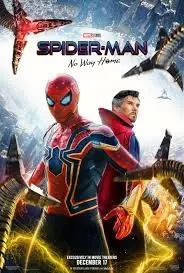Spider-Man: No Way Home – A Web of Nostalgia, Redemption, and Multiversal Madness
Introduction: The Return of the Friendly Neighborhood Spider-Man
Spider-Man: No Way Home is not just a movie—it’s an emotional event, a cinematic celebration, and a love letter to two decades of Spider-Man storytelling. Released in December 2021 and directed by Jon Watts, the film is the third installment in the MCU’s Spider-Man trilogy starring Tom Holland. But what sets it apart is its bold ambition to unite generations of Spider-Man fans by bringing together the beloved Spider-Men from different universes: Tobey Maguire, Andrew Garfield, and Tom Holland. With its perfect blend of nostalgia, character development, and high-stakes action, “No Way Home” weaves an intricate web that has left a lasting impact on the superhero genre.
The Plot: When Wishes Go Wrong
The story picks up immediately after the cliffhanger ending of “Spider-Man: Far From Home,” where Mysterio reveals Peter Parker’s identity to the world. Overwhelmed by public scrutiny and the impact on his loved ones, Peter seeks the help of Doctor Strange to erase the world’s memory of his identity. But when the spell goes awry due to Peter’s constant interruptions, the multiverse begins to fracture, pulling in villains from alternate realities who know Spider-Man’s true identity.
Enter iconic villains like Green Goblin (Willem Dafoe), Doctor Octopus (Alfred Molina), Electro (Jamie Foxx), Sandman (Thomas Haden Church), and the Lizard (Rhys Ifans). Each antagonist brings with them the weight of their original stories and unresolved fates, creating a sense of unfinished business that Peter feels compelled to address.

The Multiverse Unleashed: Fan Service Done Right
Perhaps the most talked-about and beloved aspect of the film is the return of Tobey Maguire and Andrew Garfield as their respective versions of Spider-Man. Rather than relying on mere cameos, the film gives these characters meaningful roles that complement Tom Holland’s journey. Their inclusion isn’t just a gimmick; it’s a heartfelt continuation of their stories.
Andrew Garfield’s Spider-Man, for example, gets a moment of redemption when he saves MJ from a fall, mirroring the tragic loss of Gwen Stacy in “The Amazing Spider-Man 2.” Tobey Maguire’s Spider-Man acts as a seasoned mentor, offering wisdom and calm amid chaos. These character arcs are treated with reverence and care, making their interactions not just fan-pleasing but also emotionally resonant.
Tom Holland’s Peter Parker: A Tragic Maturation
Tom Holland’s portrayal of Peter Parker has always been youthful and light-hearted, often mentored by figures like Tony Stark. But “No Way Home” marks a significant turning point in his arc. Faced with moral dilemmas, the death of Aunt May, and the responsibility of curing villains instead of defeating them, Holland’s Spider-Man is forced to grow up fast.
The loss of Aunt May is one of the film’s most heartbreaking moments, cementing the “with great power comes great responsibility” mantra into this version of Peter Parker. It acts as a rite of passage, stripping away the support systems he once leaned on and placing the weight of true heroism on his shoulders.
Villains with Depth: Second Chances and Redemption
One of the film’s strengths is how it handles its villains. Rather than treating them as one-dimensional obstacles, “No Way Home” delves into their human sides. Doctor Octopus, for example, is redeemed through Peter’s efforts to repair his mechanical arms’ inhibitor chip. Green Goblin, on the other hand, represents the ultimate test for Peter’s morality, pushing him to the brink of vengeance.
The idea of offering second chances becomes a central theme. Instead of simply sending the villains back to their respective universes to meet their fates, Peter chooses to help them. This compassionate approach differentiates him from other heroes and reinforces the core of what Spider-Man stands for.
The Cinematic Experience: A Perfect Storm of Emotion and Spectacle
“No Way Home” thrives on its ability to balance epic action with intimate character moments. From the Statue of Liberty showdown to quieter scenes of introspection and grief, the film never loses sight of its emotional core. The score by Michael Giacchino, paired with nostalgic themes from previous Spider-Man movies, amplifies the emotional impact.
The cinematography is visually dynamic, especially during multiverse-bending sequences and Spider-Man’s acrobatic web-slinging. The CGI is top-notch, particularly in seamlessly integrating characters from different cinematic eras into a cohesive world.
Cultural Impact: Breaking the Box Office and the Internet
The anticipation for “No Way Home” was unlike anything the MCU had seen before. Months of speculation, leaks, and theories culminated in a release that shattered box office records, grossing over $1.9 billion globally despite pandemic-era limitations. The movie reignited interest in previous Spider-Man franchises and sparked endless discussions, memes, and emotional fan tributes.
The film’s success is also a testament to the power of nostalgia when executed with sincerity. It didn’t just pander to fans; it honored their emotional investment over the years. “No Way Home” also set a precedent for future multiverse storytelling, showing how it can be used to enrich characters rather than just confuse or overwhelm audiences.
Themes That Resonate: Identity, Loss, and Heroism
At its heart, “No Way Home” is about identity—not just the literal secret identity of Spider-Man, but also the personal journey of discovering who you are through adversity. Each version of Spider-Man has experienced loss, guilt, and hardship, but they’ve also found resilience, hope, and purpose.
The film also explores what it means to be a hero. It’s not just about fighting villains; it’s about making hard choices, bearing the consequences, and doing what’s right even when no one remembers you. By the end of the film, Peter Parker is truly alone, but more Spider-Man than he’s ever been.
Conclusion: A Legacy That Will Swing On
“Spider-Man: No Way Home” is a triumph in superhero storytelling. It manages to celebrate the past, elevate the present, and open doors for the future. It’s a film that understands the weight of legacy while pushing its protagonist toward maturity. For longtime fans, it’s a dream fulfilled; for new audiences, it’s a compelling standalone story of growth and sacrifice.
In weaving together threads from three distinct Spider-Man franchises, the film does more than entertain—it unites. It reminds us why Spider-Man endures across generations: because he is, at his core, just a kid trying to do the right thing in a world that often isn’t fair. And sometimes, that’s the most heroic thing of all.






